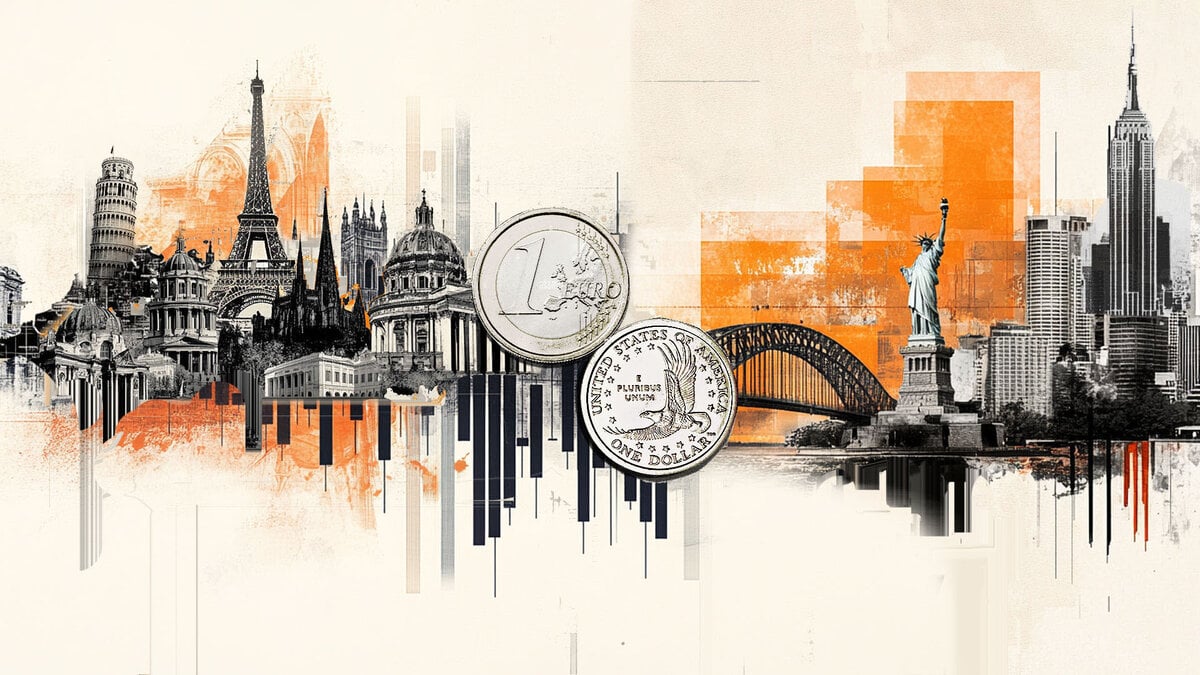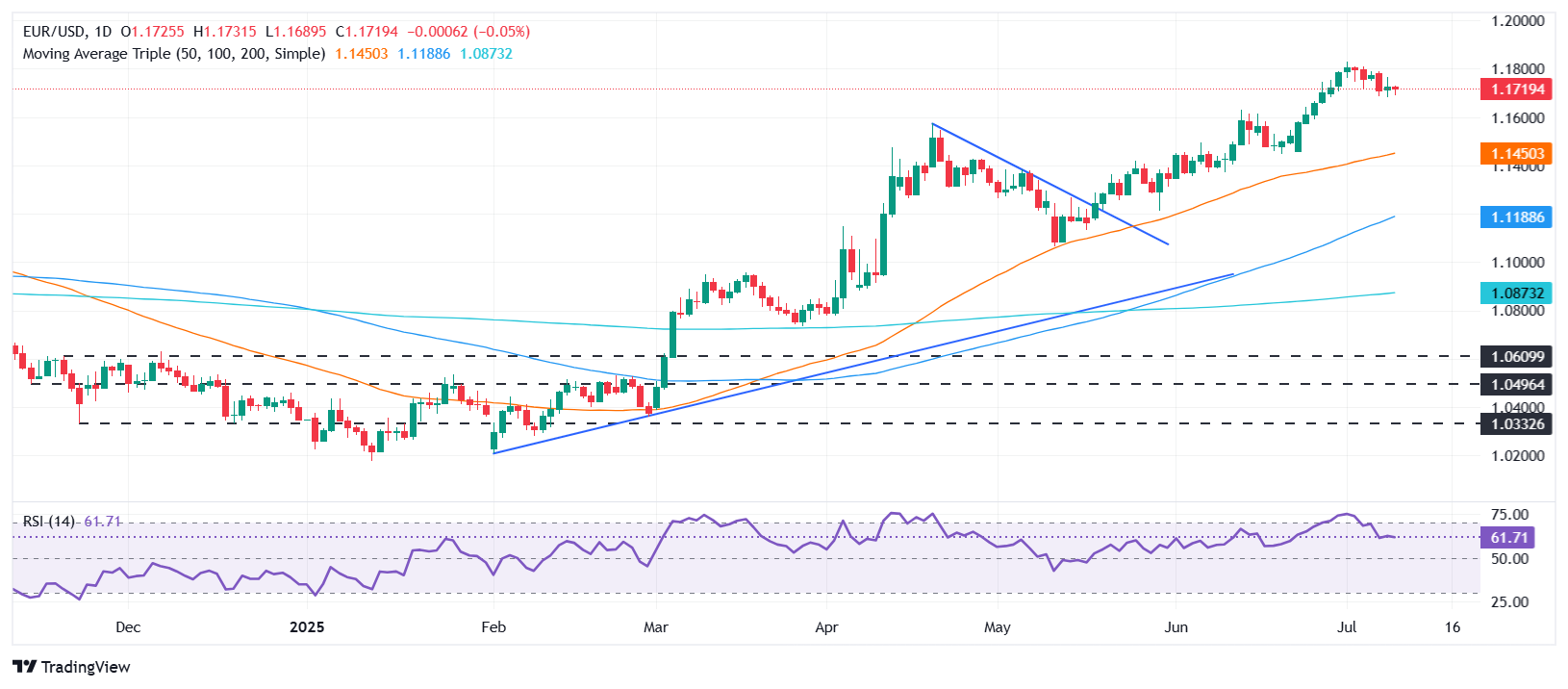Created
: 2025.07.10














![]() 2025.07.10 07:23
2025.07.10 07:23
The EUR/USD finished Wednesday's session with decent gains of over 0.17% after the Federal Open Market Committee (FOMC) released its June monetary policy meeting minutes, which showed that some officials are eyeing at least one interest rate cut. As the Asian session begins, the pair trades at 1.1715, virtually unchanged, at the time of writing.
The Federal Reserve's meeting minutes revealed that most policymakers view a rate cut later this year as a suitable option. At the same time, a few officials indicated that a reduction as early as July could be warranted, provided that incoming data aligns with their estimates.
Aside from this, Washington resumed sending tariff letters to the Philippines, Moldova, Algeria, Iraq, Libya, Brunei, Sri Lanka, and Brazil, with duties set within the 20% to 50% range.
The Euro dipped despite news that revealed that the White House didn't target the European Union (EU) with additional tariffs and that it could secure some exceptions of the baseline rate of 10%.
The strength of the Greenback pressures the EUR/USD. The US Dollar Index (DXY), which tracks the buck's value against a basket of six currencies, finished Wednesday's session flat at 97.51.
Wednesday's main driver remains trade news. Washington unveiled tariffs to the Philippines (20%), Moldova (25%), Algeria (30%), Iraq (30%), Libya (30%), Brunei (25%), Sri Lanka (30%), and lastly Brazil (50%).
Alongside this, market participants digested the latest FOMC Minutes, which showed that some Fed officials do not see a rate cut in 2025. They cited that inflation pressures remain high, along with inflation expectations edging up and ongoing economic resilience. All participants viewed the current policy rate as appropriate. Participants agreed that stagflationary risks had diminished, though they remain elevated.
Washington unveiled tariffs to the Philippines (20%), Moldova (25%), Algeria (30%), Iraq (30%), Libya (30%), Brunei (25%), Sri Lanka (30%), and lastly Brazil (50%).
Trump added that he could have been harsher on trade and announced that he would impose duties on pharmaceuticals, semiconductors, and copper, which he said would result in tariffs of around 50%.
The EU stated that there has been some progress on a framework trade deal with the United States (US), according to EU spokesman Olof Gill. He indicated that Ursula Von der Leyen held a call with Trump on Sunday, saying that "They had a good exchange."
The EUR/USD trades sideways within the 1.1700-1.1720 range, with traders still unable to break key support at 1.1700. The Relative Strength Index (RSI) shows that buyers remain in charge but are losing some momentum in the near term.
For a bullish continuation, the EUR/USD must break 1.1720 before testing the July 7 high of 1.1789. The overhead lies at 1.1800 and the year-to-date (YTD) high of 1.1829.
Conversely, if EUR/USD tumbles below 1.1700, this will expose the 20-day Simple Moving Average (SMA) as the first support level at 1.1649. A breach of the latter will expose the 1.1600 figure, followed by the 50-day SMA at 1.1448.

The Euro is the currency for the 19 European Union countries that belong to the Eurozone. It is the second most heavily traded currency in the world behind the US Dollar. In 2022, it accounted for 31% of all foreign exchange transactions, with an average daily turnover of over $2.2 trillion a day. EUR/USD is the most heavily traded currency pair in the world, accounting for an estimated 30% off all transactions, followed by EUR/JPY (4%), EUR/GBP (3%) and EUR/AUD (2%).
The European Central Bank (ECB) in Frankfurt, Germany, is the reserve bank for the Eurozone. The ECB sets interest rates and manages monetary policy. The ECB's primary mandate is to maintain price stability, which means either controlling inflation or stimulating growth. Its primary tool is the raising or lowering of interest rates. Relatively high interest rates - or the expectation of higher rates - will usually benefit the Euro and vice versa. The ECB Governing Council makes monetary policy decisions at meetings held eight times a year. Decisions are made by heads of the Eurozone national banks and six permanent members, including the President of the ECB, Christine Lagarde.
Eurozone inflation data, measured by the Harmonized Index of Consumer Prices (HICP), is an important econometric for the Euro. If inflation rises more than expected, especially if above the ECB's 2% target, it obliges the ECB to raise interest rates to bring it back under control. Relatively high interest rates compared to its counterparts will usually benefit the Euro, as it makes the region more attractive as a place for global investors to park their money.
Data releases gauge the health of the economy and can impact on the Euro. Indicators such as GDP, Manufacturing and Services PMIs, employment, and consumer sentiment surveys can all influence the direction of the single currency. A strong economy is good for the Euro. Not only does it attract more foreign investment but it may encourage the ECB to put up interest rates, which will directly strengthen the Euro. Otherwise, if economic data is weak, the Euro is likely to fall. Economic data for the four largest economies in the euro area (Germany, France, Italy and Spain) are especially significant, as they account for 75% of the Eurozone's economy.
Another significant data release for the Euro is the Trade Balance. This indicator measures the difference between what a country earns from its exports and what it spends on imports over a given period. If a country produces highly sought after exports then its currency will gain in value purely from the extra demand created from foreign buyers seeking to purchase these goods. Therefore, a positive net Trade Balance strengthens a currency and vice versa for a negative balance.
![]()
Created
: 2025.07.10
![]()
Last updated
: 2025.07.10

FXStreet is a forex information website, delivering market analysis and news articles 24/7.
It features a number of articles contributed by well-known analysts, in addition to the ones by its editorial team.
Founded in 2000 by Francesc Riverola, a Spanish economist, it has grown to become a world-renowned information website.
We hope you find this article useful. Any comments or suggestions will be greatly appreciated.
We are also looking for writers with extensive experience in forex and crypto to join us.
please contact us at [email protected].
Disclaimer:
All information and content provided on this website is provided for informational purposes only and is not intended to solicit any investment. Although all efforts are made in order to ensure that the information is correct, no guarantee is provided for the accuracy of any content on this website. Any decision made shall be the responsibility of the investor and Myforex does not take any responsibility whatsoever regarding the use of any information provided herein.
The content provided on this website belongs to Myforex and, where stated, the relevant licensors. All rights are reserved by Myforex and the relevant licensors, and no content of this website, whether in full or in part, shall be copied or displayed elsewhere without the explicit written permission of the relevant copyright holder. If you wish to use any part of the content provided on this website, please ensure that you contact Myforex.
Myforex uses cookies to improve the convenience and functionality of this website. This website may include cookies not only by us but also by third parties (advertisers, log analysts, etc.) for the purpose of tracking the activities of users. Cookie policy